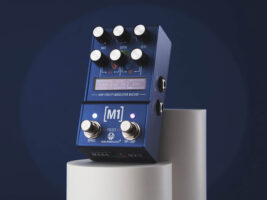
Walrus Mako M1 MKII High Fidelity Modulation Machine review – “some of the very best sounds out there”
$399/£379, walrusaudio.com
In a world where every boutique pedal builder worth their salt is seemingly getting in on the high-end DSP, it’s worth remembering that when they came along five years ago, the Walrus Mako series was a very big deal.
READ MORE: Boss PX-1 Plugout FX review – “This is a pedal that could find a home in a lot of rigs”
It was rare enough at the time for boutique builders to invest the time, resource and ingenuity required to take advantage of the sort of high-end chips we saw in big brand modellers, even less so for them to squeeze it into such a compact form factor.
Those first Makos were a hit, and so it’s no surprise that the brand has come along with a MKII version that takes what was so successful about the originals and refines them even further. These MKIIs have been around for a while now, but today we’re checking out the updated version of one of the best of the original crop – the M1 High Fidelity Modulation Machine.
Image: Adam Gasson
Walrus Mako M1 MKII High Fidelity Modulation Machine – what is it?
Like its predecessor, the M1 is designed to offer high-fidelity digital recreations of all your favourite modulation sounds – to the uninitiated that means chorus, phaser, tremolo, vibrato, rotary speaker, and filter sounds.
New for the M1 MKII is the addition of a flanger mode to one of the chorus settings, addressing what was a bit of an oversight on the original, but that’s not all. There are 18 algorithms in total, so three for each effect type, and there’s also been a fair bit of work done under the hood – several of the algorithms have been redesigned from the ground up to be more usable and better sounding, too.
The most striking difference between MKI and MKII is of course that two-inch OLED display that replaces the bank of fiddly mini-toggle switches. This means you can more easily access and tweak the various secondary functions as the display adjusts to reflect whatever you have to be tweaking.
Elsewhere, the layout has further been tidied up – the sides of the MKI were somewhat cluttered with stereo in and out jacks, a USB-C for software updates AND the power jack all on the sides. The sensible decision has been made here to shift the USB out the way up the top alongside the MIDI in and thru jacks.
Image: Adam Gasson
Walrus Mako M1 MKII High Fidelity Modulation Machine – usability
One of the truly brilliant things about the Mako range is the way Walrus distilled a lot of the sounds and functionality of a bigger modeller into a compact package that, broadly speaking, put everything you needed on the pedal where any idiot (hello!) could quickly work out what he’s doing.
The worry when adding a screen to proceedings is that you’re going to, by design really, add extra functionality that will necessitate both menu-diving and manual consultation – the true nemesis of any lazy and technology-adverse guitar player.
There’s no doubt that there is an element of that with the MKII – it’s not as WYSIWYG user-friendly as the original, and you probably will need a scan of the online user guide to make sure you know what you’re doing.
At its core things are initially pretty straightforward still – there’s the big central rotary to select which type of effect you want to use, but now you’ll need to click on that knob to cycle through the three modes rather than select it with a mini-toggle.
Above you’ll find three global controls for rate, depth and lo-fi (more on that in a minute) and then you have two further ‘encoder’ rotaries that control what’s being displayed on the screen.
The left hand rotary controls the ‘parameters’ functions – which to those of us who don’t speak Walrus means things like the modulation type, the waveform symmetry, the stereo spread of the tremolo and the attack on the filter effects. There are loads; three for each position, and each can then be cycled through using our old friend the clicky knob.
The right-hand encoder is given over to the various fun bits of the ‘lo-fi’ aspect of this pedal. You can individually set the levels of various parameters like – say, tape age, saturation or noise – and then this whole gumbo can then be added to taste using the global control above it.
If all that seems like a lot to get your head around, well that’s why there are 128 MIDI-recalable presets – or nine onboard the pedal itself. You’re going to need them, because honestly who fancies messing around with all that in the heat of a gig?
One thing that hasn’t fully been fixed since the MKI is that Walrus aren’t exactly giving you a lot of help in that regard either – while the brightness of the OLED doubtlessly makes things easier to see on the fly, actually tweaking the thing is still a fiddly and fraught affair.
Image: Adam Gasson
Walrus Mako M1 MKII High Fidelity Modulation Machine – sounds
One thing that absolutely set the original M1 apart from so many other compact modulation pedals was the variety and quality of the sounds, and there’s little doubt that the MKII version raises that bar again.
Do most of us really need three Leslie speaker sounds at our toe-tips? Surely not, but the subtle nuances that Walrus has managed to capture between the standard, moving horn and moving drum modes here are really wonderful to hear played out – especially when you start messing around with the mic-distance control.
And it’s the same story across the board, the chorus sounds are lush, deep and inviting – especially the gloriously 80s tri-chorus mode, which will have you sizing up an Armani suit with big shoulder pads in a matter of minutes. I certainly didn’t miss the replaced dual-chorus mode as a result, and the presence of the flanger here instead is very welcome. It’s a pleasantly wooshy thing that can get a bit out of hand if you’re not careful but sometimes that’s all part of the fun, isn’t it?
A good tremolo sound is one of the most sumptuous places to hang out for any guitar player, and I was particularly taken with the Pattern mode, which uses the shape and symmetry parameters to make all sorts of juddery, off-kilter throbs. Bags of fun.
As with the MKI, the secret ingredient of all this is that lo-fi mode, and the extra control and editing you can do over the various parameters now is a great way to dial in just the right amount of weird to enhance your sound without it seeming too artificial.
Image: Adam Gasson
Walrus Mako M1 MKII High Fidelity Modulation Machine – should I buy one?
If you’ve already got an M1 MKI, I would say there are some very limited reasons to upgrade here – the sounds are broadly very similar and there was absolutely nothing wrong with them in the first place.
If the thing you liked about the original was its ease of use and simple operation, I would stand firm where you are, but if you’ve been pining for the ability to get more control and more tweakability out of your sounds, this really is a no-brainer – it offers a huge amount of editable parameters without any tedious nested menus or what have you.
If, however, you don’t own a MKI and are just after a fantastic and comprehensive modulation pedal that takes up minimal space on your board while offering you some of the very best sounds out there? This is another home run for Walrus and its Mako platform.
Walrus Mako M1 MKII High Fidelity Modulation Machine – alternatives
If you want a similarly compact modulation pedal that isn’t skirting PS5 price territory, the Electro-Harmonix Mod 11 ($123) sounds nowhere near as good as the Walrus but it’s still pretty good and has loads of sonic options. If peerless sound is your goal and space and precise are less of an issue, then both the Strymon Mobius ($449/£399) and the Eventide H90 Harmonizer ($899/£845) are big, brilliant and, certainly in the case of the Eventide, eye-wateringly expensive.
The post Walrus Mako M1 MKII High Fidelity Modulation Machine review – “some of the very best sounds out there” appeared first on Guitar.com | All Things Guitar.
Source: www.guitar-bass.net











